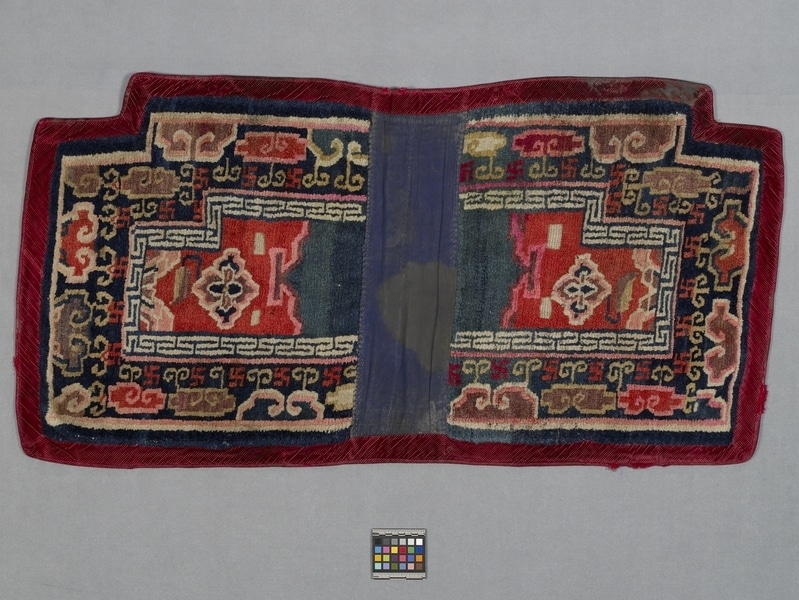Saddle Blanket Item Number: 1228/7 from the MOA: University of British Columbia

Description
Decorative, multicoloured saddle blanket, rectangular in shape and consisting of two identical square panels of thick knotted pile, separated by a 14.5 cm centre strip of dark blue cotton textile. Each of these panels is embellished with ram’s head, swastika and Greek key border motifs, surrounding a large diamond-shaped lozenge containing stylized floral motifs. The motifs are predominantly red, pink, light brown and off-white on a dark blue background; the lozenge shaped pattern appears on a red background. Two corners of the rectangle are notched. There are four small rectangular spots that are devoid of pile, exposing the burlap base fabric, two on either panel, which would be under the saddle when in use. The edges of the saddle blanket are bound with a wide (3.5-4 cm) band of red cotton corduroy, cut on the bias, and the back of the blanket is lined with pieced off-white cotton canvas.
History Of Use
Placed under a saddle to protect the horse from irritation. It is colourful and decorative and thus might have been used in a ceremonial context. Uncertain if it originated in Tibet; possibly Nepal?
Iconographic Meaning
Ram’s head motifs, swastikas (also called gammadion cross, cross cramponnée and manji) and Greek key motifs are ancient symbolic motifs commonly found on Asian textiles, clothing, furnishings and other utilitarian objects as symbols of prosperity, good fortune, eternity, unity and glory. Greek key (or meander) motifs symbolize eternity, infinity, unity; they often appear in Asian decoration.
Item History
- Made in Tibet ?
- Collected in Afghanistan ?
- Owned by Alan Davidson before August 14, 1987
- Received from Alan Davidson (Seller), Museum of Anthropology Shop Volunteers (Funding source) and Ruth Read Bequest (Funding source) on August 14, 1987
What
- Name
- Saddle Blanket
- Identification Number
- 1228/7
- Type of Item
- blanket
- Material
- wool fibre, dye and cotton fibre
- Manufacturing Technique
- knotted pile
- Overall
- height 1.2 cm, width 118.0 cm, depth 61.5 cm
Who
- Culture
- Tibetan
- Previous Owner
- Alan Davidson
- Received from
- Alan Davidson (Seller), Museum of Anthropology Shop Volunteers (Funding source) and Ruth Read Bequest (Funding source)
Where
- Holding Institution
- MOA: University of British Columbia
- Made in
- Tibet ?
- Collected in
- Afghanistan ?
When
- Ownership Date
- before August 14, 1987
- Acquisition Date
- on August 14, 1987
Other
- Item Classes
- textiles
- Condition
- good
- Accession Number
- 1228/0007